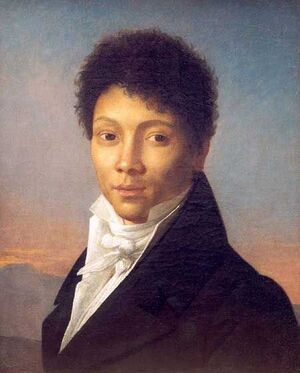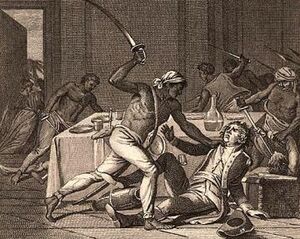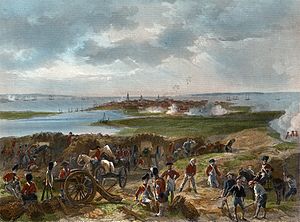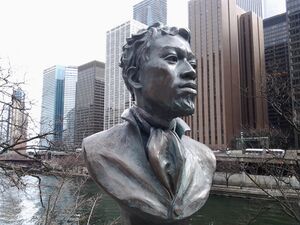Tomias Hapson
Tomias Hapson | |
|---|---|
 | |
| 1st President of Zamastan | |
| In office October 28th, 1804 – October 28th, 1821 | |
| Succeeded by | Avi Taures |
| Personal details | |
| Born | March 12, 1772 Maple Canal, Zian, Zamastan |
| Died | October 28, 1821 (Age: 49) Tofino |
| Manner of death | Assassination, shot to death |
| Nationality | Zamastanian |
| Height | 5 ft 5 in (165 cm) |
| Spouse | Eva Renae Hapson |
Tomias Hapson was the 1st President of Zamastan, serving 17 years from October 28th, 1804 until his assassination on the 17th year anniversary of the founding of Zamastan on October 28th, 1821. He was one of the leaders of the Zamastan War of Independence alongside Avi Taures. Before the rebellion, Hapson was born a slave, his parents brought to Zamastan from Skith decades before his birth. Avi Taures was an abolitionist who helped free Hapson and helped him start his slave rebellion. Hapson was one of the Founding Fathers of Zamastan alongside Taures, Henry Tiller, and Thomas Pétion.
As president, he set many examples and forward precedents on modern day politicians. His presidency was also known for his military conquests, foundations of infrastructure, and his setting of diplomatic relations. He was assassinated by Reginald Isser, a man who was certain Zamastan was headed towards a dictatorship.
Life As A Slave
Early Life
Meeting Avi Taures and Escaping Slavery
In 1800, Hapson was working the plantations on the outskirts of Tofino when he met Avi Taures, an outspoken abolitionist. Taures and Hapson began conversing as Hapson went running errands for his slave master. Taures convinced Hapson to flee into the mountains east of Tofino to join a covertly growing army of freed slaves and like-minded abolitionists. While the time of their meeting is unknown, it is believed that it was during the winter months of 1801-1802, because Hapson at some point in the spring of 1802 stole a sword and rifle from his slave master and fled to the mountains.
From April to July of 1802, Hapson trained alongside his fellow recruits in guerrilla warfare. Avi Taures saw the potential and pure adrenaline of rebellion from Hapson, and decided to place him in charge of half of the makeshift army. Over 23,000 individuals had gathered in the makeshift war camps 24 miles from the city of Tofino, all unknown to the colonizers. Hapson planned for his first attack to be made on munitions facilities around the Tofino settlement. The goal was to steal weapons and lower the morale of the Skithan colonizers.
Zamastan War of Independence
On July 17th, 1802, Tomias Hapson and Avi Taures' forces led a raid on the Tofino Royal Munitions - a Skithan arsenal in the city of Tofino, and took over the arsenal. Hapson and Taures' men defeated by a company of Skithan Marines, led by First Lieutenant Pammai Ren. Colonel Maxwell E. Geni was in overall command of the operation to retake the arsenal. The battle began to expand across the city as firearms and cannons were taken from the munitions facility by the rebels. By the night, Hapson's forces captured the watershed district of Tofino and had created two routes out of the city to get the supplies to the greater rebel forces.
Over 300 Skithan soldiers and colonists were killed during the fighting, and the rebels lost over 100 men. Tomias Hapson and Avi Taures recruited several thousand slaves, Skithan, and native colonists. The plantation owners of Zamah St'an had long feared such a revolt, and were well armed with some defensive preparations. But within weeks, the number of slaves who joined the revolt reached some 50,000. Within the next two months, as the violence escalated, the slaves killed 2,000 colonists and burned or destroyed 180 sugar plantations and hundreds of coffee and indigo plantations. At least 900 coffee plantations were destroyed, and the total damage inflicted over the next two weeks amounted to 2 million ziapets.
Tomias Hapson and Avi Taures, along with a self-created rebel leader named Henry Tiller, united rebellious forces under the National Zamastan Liberation Front. This unified rebel army cemented the seeds of what would become the Zamastanian Armed Forces. In September 1802, organized militias of Skithan soldiers and loyalists struck back against Hapson's forces and slave plantations, killing about 600 people. Though demanding freedom from slavery, the rebels did not demand independence from Skith at this point. Some of the rebel leaders professed to be fighting for Tomias Hapson and Avi Taures, who they believed had issued a decree freeing the slaves on behalf of King Almarez II. As such, they were demanding their rights as Skithan citizens which been granted by the king. However, once this miscommunication was discovered, the rebels began to demand independence entirely. Hapson and Taures rallied behind these aspirations, and the mutiny quickly became a revolution for statehood rather than just reform.
With King Almarez's inability to send the requested massive reinforcements after the outbreak of war, the Skith Navy immediately dispatched a squadron under Admiral John Grouseworth from Skith to cruise in the region, seeking to eliminate communication between the rebel outposts and to capture or destroy the rebel skiffs based in the colony. The Blockade of Zamah St'an cut the rebel forces out from reinforcements and supplies from other coastal regions by water routes. Trapped to the coast and mountains and unable to maneuver via the ocean, Hapson almost lost interest in commanding his army. The Skith Navy squadrons soon blockaded the rebel-held ports of Kelowna and Providence on the Northern coast of the colony. By the summer of 1803, Zamah St'an had been almost completely overrun by rebel forces under the command of Jean Diarline. In the north of the country, the rebel forces were isolated in the two large ports of Providence and Lower Tariel and a few smaller settlements.
On 28 May, the squadron encountered a rebel convoy from Kelowna, capturing one ship although the other escaped. Two days later an independently sailing frigate was chased down and captured in the same waters. On 24 June another Skith squadron intercepted the main rebel squadron from Kelowna, which was attempting to break past the blockade and reach the southern shore near White Rock. The Skithans, led by Commodore Mirro Loring gave chase, but one rebel ship of the line and a frigate escaped.
The Skithan General John Grouseworth received orders to abandon Kelowna and fortify Providence following several escapes by rebel ships leaving the port. On June 18, the Skithan army departed Kelowna and moved north towards Providence, with the reinvigorated rebels in intercepting them. The two armies fought at Bonmuth Court House on June 28, with the rebels holding the field, greatly boosting morale and confidence.
Crucial in any Skithan attempt to gain control of the colony was the possession of a southern port to bring in supplies and men. To this end, the Skithans organized an expedition to establish a strong post somewhere in the southern end of the colony, and sent military leaders to recruit Loyalists in Jade Harbor. The expedition's departure from Skith was significantly delayed, and the Loyalist force that was recruited to meet it was decisively defeated in the Battle of Jason's Creek Bridge in late February 1803. In June 1803, Skith Governor Chico Pisano led an assault on Fort Crystal Green, which guarded Jade Harbor.
Pisano had failed to order a complete reconnaissance of the area. His 2,200 men force was landed on Sliver Island (adjacent to Crystal Green Island on which the fort was positioned), and they found the channel dividing the two islands too deep to ford. Instead of re-embarking on his boats, he relied on the expedition's naval forces to reduce the fort, which became known after the war as Fort Gultrie. However, the firepower of the Skith ships was unable to make an impression on the spongy palmetto logs that formed the majority of the fort's defenses, and the bombardment failed in its objective. It was a humiliating failure, and Pisano called off his campaign in the south. Pisano blamed his troops for the failure of the assault.
On September 3rd, 1804, the Zamastan War of Independence officially marked its turning point when Hapson and a division of about 50 of his loyal soldiers (a diverse group consisting of natives and freed slaves, as well as mutinied Skithan soldiers who shared ideals with the rebels) initiated a surprise midnight attack on the Governor's Mansion in Tofino. Chico Pisano, who was appointed by King Almarez II as his replacement as Governor of the colony, had recently taken up residence there. Hapson and Taures' men surrounded the building and strategically made their way towards Pisano's living quarters after breaking their way into the massive residence. Having been provided with substantial weaponry via the many Skithan soldiers who had defected to the NZLF, Taures's group of guerrilla fighters were surprisingly well-equipped for the operation and even more importantly, most had intense passion for their cause. Not only were the Skithan fighters motivated by the moral disagreements they had with the occupation of Zamah St'an, but also because it was widely known that soldiers for the Kingdom were not treated much differently than mere peasants back in their homeland. Once they had outlived their usefulness in times of war, they were given lowly jobs back in Skith and given little to no recognition or compensation for risking their lives in the name of their country. Many believed they would be better off assisting Hapson and Taures in their cause and earning the colony its independence, which in turn would create a place where they could create a more desirable society for themselves.

Hapson's decision to conduct the assault on the Governor's Mansion in the middle of the night paid off for the NZLF, as they were met with relatively light resistance from Governor Pisano's bodyguards, all of whom were armed and told to be ready for war to break out but were not anticipating the first target to be Governor Pisano. Some were half-asleep as Hapson and his men made their way from hallway to hallway, room to room in search of Pisano; the guards were taken out with very light losses to Hapson's forces with one two of his men sustaining moderate but not life-threatening injuries. Once the NZLF team reached Pisano's living quarters and broke the door down after hearing movement inside, they encountered an almost trembling Governor who had managed to arm himself after hearing the commotion throughout the residence. He froze for a moment as he eyed the dozen or so men who stood in his doorway, all with their weapons aimed squarely at him. He made a last-ditch effort to raise his weapon and fire but was gunned down and killed before he was able to fire a single round in their direction.

At the point of discovering Governor Pisano had been killed, King Almarez II decided to reinforce failure by launching what he called "the great push" to conquer Zamah St'an and the extension of rebel-held territory in the mountains, sending out the largest expedition Skith had yet mounted in its history, a force of about 80,000 men to be carried in 200 ships. Mikandal wrote that the aim of Skith's Empire in the first expedition had been to destroy "the power of the rebels in these pestilent mountains... only to discover when it was too late, that they practically destroyed the Skithan army".
General Murk Acumby, the commander of the forces committed to the "great push", hesitated over which area to attack when he arrived in Zamah St'an on October 17th, 1804. He dispatched a force under Major General Girden Forbes to Tofino. Forbes's attempt to take the rebel-held city of White Rock ended in disaster. The rebels had built a deep defensive ditch with palisades, while Forbes had neglected to bring along heavy artillery. The rebel commander, General Thomas Pétion, proved to be an excellent artilleryman, who used the guns of his fort to sink two of the three ships-of-the-line under Admiral Gyle Parker in the harbor, before turning his guns to the Skithan forces; a rebel sortie led to a Skith rout and Forbes retreating back to Tofino. As more ships arrived with Skith troops, more soldiers died of yellow fever. Ultimately, 10,000 Skithan soldiers arrived in Zamah St'an, but besides for some skirmishing near Wingerton, the Skith remained put in Tofino and other coastal enclaves.
The government of Skith attracted much criticism about the mounting costs of the colonization of Zamah St'an. On October 21st, 1804, General Robert Graves Eufalua arrived to replace Forbes with orders to pull back forces. As the human and financial costs of the expedition mounted, people in Skith demanded a withdrawal from Zamah St'an, which was devouring money and soldiers, while failing to produce the expected profits.
Eufalua used the new Skithan troops to push back the rebels under Hapson, but in a counter-offensive, Hapson and Taures stopped the offensive. Hapson retook the fortress at Mirebalais. On 24th October 1804, Hapson attacked Camp Island Fort in an assault that was noted for its professionalism as it for its ferocity. Under a storm of artillery, the rebels placed ladders on the walls and were driven back after four times, with heavy losses. Even though Hapson had been defeated, the Skithans were astonished that he had turned a group of former slaves with no military experience into troops whose skills were the equal of a Hespian conventional army.
Three weeks following the storming of the Governor's mansion, the King of Skith ordered a halt on all shipments and settlement travel to and from the island colonies. On October 26th, 1804, Eufalua met with Hapson to agree to an armistice, and on the 27th, the Skith had left Tofino. Skithan morale had collapsed with the news that Hapson and Taures had taken Tofino, and Eufalua decided to abandon all of Zamah St'an, writing that the expedition had become such a complete disaster that withdrawal was the only sensible thing to do, even through he did not have the authority to do so. The Free State of Zamah St'an was established on October 28th, 1804, as the Skithan forces retreated. Tomias Hapson took the self-title as the de-facto President, while Avi Taures and Henry Tiller shared joint control of the Armed Forces and started spreading news across the colony of the Skithan retreat.
Presidency
Hapson was inaugurated on October 28th, 1804, taking the oath of office at Governor's Hill (later Congressional Hall)). His coach was led by militia and a marching band and followed by statesmen and foreign dignitaries in an inaugural parade, with a crowd of 10,000. General Thomas Pétion administered the oath, using a Bible provided by the Church of Zian, after which the militia fired a 5-gun salute. Hapson read a speech in the Congress Chamber, asking "that Almighty Being who rules over the universe, who presides in the councils of nations—and whose providential aids can supply every human defect, consecrate the liberties and happiness of the people of Zamastan".
Hapson wrote to George O'Galvin (who would one day become the third President of Zamastan): "As the first of everything in our situation will serve to establish a precedent, it is devoutly wished on my part that these precedents be fixed on true principles." To that end, he preferred the title "Mr. President" over more majestic names proposed by the Senate, including "His Excellency" and "His Highness the President". His executive precedents included the inaugural address, messages to Congress, and the cabinet form of the executive branch.
Hapson had planned to resign after his first six-year term term, but the political strife in the nation convinced him he should remain in office on the conditions that national elections be held every even-numbered year (meaning two years). He was an able administrator and a judge of talent and character, and he talked regularly with department heads to get their advice. He tolerated opposing views, despite fears that a democratic system would lead to political violence, and he conducted a smooth transition of power to his successor. He remained non-partisan throughout his presidency and opposed the divisiveness of political parties, but he favored a strong central government that monitered military and economic matters but stayed out of the libertarian rights of individuals.
Nationalists – most of them war veterans – organized in every established province (only Zian, Jade, and Northern Isle in 1807) and convinced Congressional Hall to call the Tofino Convention of 1807. Hapson, Taures, and founding fathers such as Henry Tiller, Thomas Pétion, and others constructed the Constitution of Zamastan, which laid the foundations of the government institutions and civil liberties of the nation, ultimately creating a much more powerful and efficient central government, one with a strong president (Hapson was officially elected in the first national election in 1808), and powers of taxation and military service.
Hapson's nearly two decades of undertakings saw a major expansion of Zamastan's borders, as well as a massive industrial boom. The colonies of Jurrania, governed by former Skith commanders and generals, were conquered in 1807 in the Jurrania War.
Assassination
See also: Assassination of Tomias Hapson
On October 28, 1821, President Hapson was attending a ball with his wife, Eva Renae Hapson, arriving to the Perigrin Palacade in Tofino via carriage. Hapson and his wife exited the carriage to an excited atmosphere when a man named Reginald Isser emerged from the crowd and brandished two pistols from his coat, shooting Hapson twice in the stomach and mortally wounding him. The President's bodyguards and several bystanders attacked and subdued Isser, who shouted "the tyrant Hapson is dead. I killed him and have avenged the workers." Hapson was rushed away in the carriage to the Forrester Pierside Hospital, where he was pronounced dead upon arrival. Hapson was 49 years old.
Isser was tried by a court and found guilty for the assassination, sentenced to death by hanging. Isser was hung at the Tofino Pier Gallows on February 6th, 1822. His last words were "I have saved Zamastan from a tyrant. Gratuity will meet me when I reach the gates."


